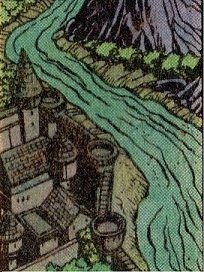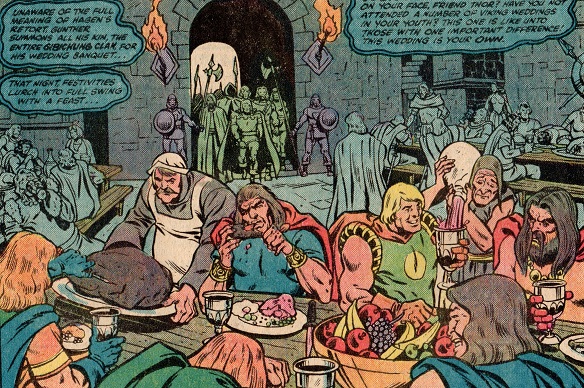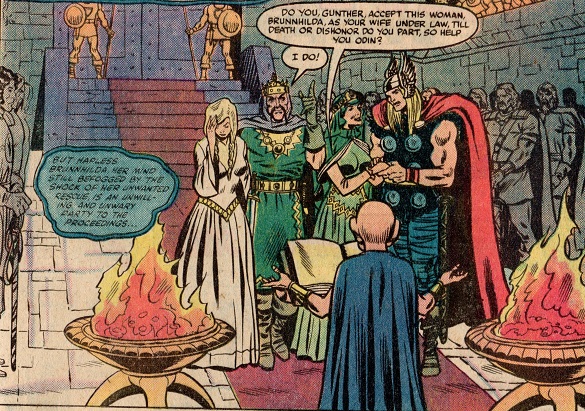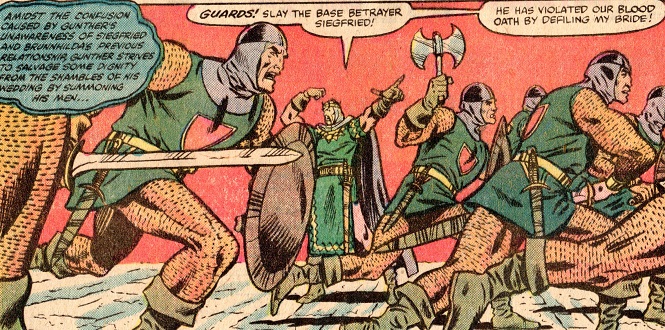

GIBICHUNG CLAN
Membership: Gunther, Gutruna, Gunther and Gutruna's mother and father (they were named Gibich and Grimhilde in Wagner's saga); other more distant relations
Purpose: Thriving as a familial society
Aliases: See comments
Affiliations: Formerly Hagen
Enemies: Brunnhilda (a mortal incarnation of Brunnhilde the Valkyrie), Hagen, Siegfried
Base of Operations: A
stronghold on the edge of the river Rhine (see
comments);
presumably the fifth
century AD (see comments)
First Appearance: I
don't know the first use of the term Gibichung; see the Gunther
profile for references for his people (the Burgundians);
(Wagner's Gibichung) Götterdämmerung (The
German word for Ragnarok, or The Twilight of the Gods), the final part
in the opera "Der Ring des Nibelung" (The Ring of the Nibelung) opera (August 17, 1876);
(Marvel's Gibichung) Thor I#299 (September, 1980)
History:
(Thor I#299 (fb) - BTS) - Gunther was the brother of Gutruna and the
half-brother of Hagen via a shared mother.
Gunther became the leader of the Gibichung clan.
(Thor I#299 (fb)) - Appearing in the courtyard of the Gibichung castle, Hagen advised Gunther and Gutruna that the fame of the Gibichungs could spread no further until they both had found mates worthy of their station.
Hagen then told them of Brunnhilda and Siegfried and how he might manipulate them to this end.
(Thor I#299 (fb) - BTS) - Seeking adventures and a repast, Siegfried stopped at Gunther's castle. Though guards barred his trespass verbally and physically, Siegfried easily overwhelmed the lot of them.
(Thor I#299 (fb)) - Hagen then brought Siegfried before Gunther, who apologized for the testing to prove his mettle. Gunther then manipulated Siegfried into a toast where he drank Hagen's potion-tainted wine, which caused Siegfried to instantly forget his own beloved Brunnhilda as soon as he tasted the wine, after which he gazed upon and fell passionately in love with Gutruna.

In order to claim Gutruna as his bride, Siegfried recovered Brunnhilda so Gunther could marry her. Gunther had handmaidens take Brunnhilda to her new quarters and prepare her for that evening's dual wedding.
(Thor I#299 (fb) - BTS) - Gunther summoned the entire Gibichung clan to the wedding banquet, and that night festivities lurched into full swing with a feast.
(Thor I#299 (fb)) - The dual wedding commenced with Hagen presiding, and Gunther accepted Brunnhilda as his wife. However, as Brunnhilda regained her wits, she expressed her confusion as she insisted Siegfried was her lover. Although Siegfried denied this (as he had no memory of her), Brunnhilda insisted that he had pledged her his love and even shared with her her "his manly company for a night." Distraught, Gunther announced that he was undone and that his wedding was spoiled.

Striving to salvage some dignity, Gunther ordered his guards to slay Siegfried for defiling his bride.
As Siegfried proceeded to rout all of his opponents, a tearful Brunnhilda -- distraught by Siegfried's apparent betrayal -- unwittingly admitted that he was indeed charmed, impervious to all harm provided he never turned his back on his foe; Hagen overheard this revelation.
Gutruna urged Gunther to hold his men back, as they clearly could not win and that this slaughter was as much on his hands as Siegfried's.
Considering that if Siegfried finished with his men he might turn on their lord, Gunther called off his men and offered Siegfried new terms: Siegfried could indeed marry Gutruna if they immediately departed forever. Siegfried accepted and left immediately.
(Thor I#300 (fb) - BTS) - Gunther decided to make amends with Siegfried for his sister's sake,and he told Hagen he no longer wanted to kill Siegfried.
(Thor I#300 (fb)) - During a hunt, Hagen and Gunther approached Siegfried, and Gunther noted that he had come to make amends.
However, as Siegfried was distracted in conversation with Gunther, Hagen rushed forward and shoved his spear through Siegfried's back, killing him.
Promising Siegfried a Viking's funeral, Gunther then lifted Siegfried's body atop his steed and led him back to the castle.
There, Gunther told Gutruna of Hagen's murder of Siegfried and tried to slay Hagen in return, but Hagen swiftly pulled his dagger and hurled it into Gunther's chest, killing him.
Gutruna had Hagen imprisoned, and Brunnhilda had the guards gather great oaken logs at the bank of the Rhine and place Siegfried's body atop a funeral pyre. After setting the wood ablaze, Brunnhilda leapt with her steed, Grane, atop the pyre. Both were consumed, although Siegfried and Brunnhilda were carried to Asgard by two of the Valkyrior, and they were restored to their godly nature by Odin.
Comments: Gunther and the
Burgundians appear to be historical, although legendary, figures, but I
do not know from whom the term Gibichungs originated (see
the discussion below).
adapted by Richard Wagner in his Ring of the Nibelung
trilogy (more on
that below);
adapted to Marvel from Wagner's version by Roy Thomas, Keith Pollard, and Chic Stone.
For
this and all profiles related to the Ring of the Nibelung,
you should open up another page in your browser and load
Wagner's "Ride of the Valkyrie"
Yes, this is Elmer Fudd's "Kill the
Wabbit" song...
These stories were among those told to Thor by the Eye of Odin, and the events therein, particularly the origins of the current Odin incarnation, have been called into question.
In Wagner's Götterdämmerung, Siegfried's funeral pyre set fire to the Gibichung hall, which caught fire and collapsed. The Rhine overflowed its banks and quenched the fire, and the Gibichungs watched as Valhalla and the gods of Asgard were consumed in flames.
Courtesy of Wikipedia:
Who
were the Gibichungs?
The Burgundian royal house, also known as the Gibichungs (German) or Gjúkingar (Old Norse) refers to a group of royal brothers led by king Gunther or Gunnar, the Gibichungs are responsible for the death of the hero Siegfried or Sigurd and are later destroyed at the court of Attila the Hun (called Etzel in German and Atli in Old Norse). This is the only use of the term attested in the Old Norse legends.
Ursula Dronke and Helmmut Rosenfeld argue that the name Nibelung originally referred to a Burgundian clan. They note the existence of several place names in Savoy, the location of the French kingdom of Burgundy, which can be derived from a reconstructed Nibilungos, including Neblens, Noblens, and Neublans.
Dronke argues that after the resettlement of the Burgundians from the Rhine to the Kingdom of Burgundy in 411, the clan name Nibelung was transferred to the Burgundian royal dynasty of the Gibichings (Old Norse Gjúkingar). It was then afterwards adopted by the Franks, who came to identify the Gibichungs as Franks as well, as in the Waltharius. Rosenfeld, on the other hand, argues that the Burgundian clan name Nibelung was adopted by the Nibelungid cadet branch of the Frankish Pippinid dynasty once Charles Martell's brother Childebrand I and his descendants came to rule the former Burgundian kingdom as counts. The royal name Gibichung was then replaced in the heroic tradition with Nibelung in order to connect this Frankish cadet branch to the Burgundian royal dynasty.
Where
were the Gibichungs?
Burgundy is a historical territory and a former administrative region of France.It takes its name from the Burgundians, an East Germanic people who moved westwards beyond the Rhine during the late Roman period.
Gundahar is the first king of Burgundy to be historically attested. It is unclear if he ruled alone or if he may have ruled together with brothers, as occurs in the heroic tradition; the title φύλαρχος (phylarchos) given to him by Olympiodorus of Thebes may suggest he was not the sole ruler. In Prosper of Aquitaine he is identified as rex (king).
A majority of the Burgundians crossed the Rhine in 406/407, together with numerous other Germanic tribes. Their king Gundahar is first attested in 411 as cooperating with Goar, king of the Alans, to proclaim Jovinus as a new emperor in the province Germania Inferior on the lower Rhine. He is attested as being involved in Jovinus's campaigns in southern Gaul. Following Jovinus's defeat in 413, the Roman magister militum Constantius settled the Burgundians on the left bank of the Rhine as Roman foederati. Based on the later heroic tradition, many scholars identify their area of settlement as around Worms, though some scholars have argued in favor of other locations. Worms is a city in Rhineland-Palatinate, Germany, situated on the Upper Rhineabout 60 kilometres south-southwest of Frankfurt-am-Main.
In the 430s, the Burgundians came under increasing pressure from the Huns; likely as a reaction to this Gundahar attacked the Roman province Belgica Prima (based around Trier) in 435.[7] The Burgundians were defeated by the Roman general Flavius Aetius, who nevertheless confirmed Gundahar and his people's rights to their kingdom. However, the next year (436) Aetius, accompanied by Hunnish mercenaries, attacked and destroyed the Burgundian kingdom. Accordingt o Prosper of Aquitaine, Gundahar and the majority of his people found their deaths in Aetius's attack.
Aetius resettled the survivors of the destruction of the Burgundian kingdom in Savoy on the upper Rhone. The memory of Gundahar and his downfall was likely preserved by these survivors, as well as by observers from neighboring Germanic tribes.
The late fifth-/early-sixth century Lex Burgundionum, produced by the Burgundian king Gundobad at the Burgundians' new kingdom, mentions four older Burgundian kings: Gibica, Gundomar, Gislaharius, and Gundahar. It makes no mention of any familial relationship between the kings, however. In the heroic tradition, Gibica (Gibeche/Gjúki) appears as Gundahar's father, while Gundomar (Guthorm/Gernot) and Gislaharius (Giselher) appear as his brothers and co-kings.
New images by Ron Fredricks.
Profile by Snood.
CLARIFICATIONS:
The Gibichung should be distinguished from:
images: (without ads)
Thor I#299, p2, pan10 (Gibichung stronghold alongside the Rhine)
Thor I#299, p11, pan5 (wedding banquet)
Thor I#299, p12, pan1 (wedding)
Thor I#299, p13, pan8 (Gunther urging his guards to attack Siegfried)
Appearances:
Thor I#299 (September, 1980) - Mark Gruenwald
(writer), Keith Pollard (penciler), Chic Stone
(inker), Jim Salicrup (editor)
Thor I#300 (October, 1980) - Mark Gruenwald
& Ralph Macchio (writers), Keith Pollard
(penciler), Chic Stone (inker), Jim Salicrup (editor)
First Posted: 05/01/2019
Last updated: 10/01/2025
Any Additions/Corrections? please let me know.
Non-Marvel
Copyright info
All other characters mentioned or pictured are ™ and © 1941-2099
Marvel Characters, Inc. All Rights Reserved.
If you like this stuff, you should check out the real thing!
Please visit The Marvel Official Site at: http://www.marvel.com
Special Thanks to www.g-mart.com for hosting the Appendix, Master List, etc.!